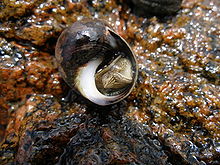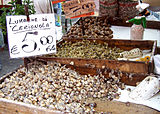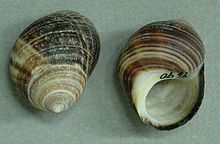- Common periwinkle
-
"Winkle" redirects here. For the contract bridge play, see Winkle squeeze.
Common periwinkle 
Periwinkle emerging from its shell, Sweden Scientific classification Kingdom: Animalia Phylum: Mollusca Class: Gastropoda (unranked): clade Caenogastropoda
clade Hypsogastropoda
clade LittorinimorphaSuperfamily: Littorinoidea Family: Littorinidae Genus: Littorina Species: Littorina littorea Binomial name Littorina littorea
(Linnaeus, 1758)[1]Synonyms[2] - Littorina armoricana Locard, 1886
- Littorina bartonensis Brown, 1843
- Littorina communis Brown, 1843
- Littorina litorea (Turton, 1819)
- Littorina litorea var. brevicula Jeffreys, 1865
- Littorina litorea var. paupercula Jeffreys, 1865
- Littorina litorea var. sinistrorsa Jeffreys, 1865
- Littorina litorea var. turrita Jeffreys, 1865
- Littorina littorea f. intermedia Brøgger, 1901
- Littorina littorea var. angulata Harmer, 1920
- Littorina littorea var. antiqua Wood, 1848
- Littorina littorea var. balteata Dautzenberg & Durouchoux, 1912
- Littorina littorea var. complanata Harmer, 1920
- Littorina littorea var. conica Harmer, 1920
- Littorina littorea var. deformis Wood, 1848
- Littorina littorea var. delphinula Wood, 1848
- Littorina littorea var. distorta Harmer, 1920
- Littorina littorea var. elegans Wood, 1848
- Littorina littorea var. fuscofasciatus Middendorff, 1849
- Littorina littorea var. major Dautzenberg & Durouchoux, 1913
- Littorina littorea var. miniata Dautzenberg & Durouchoux, 1900
- Littorina littorea var. pallida Dautzenberg & Durouchoux, 1900
- Littorina littorea var. pallidefasciatus Middendorff, 1849
- Littorina littorea var. parva Harmer, 1920
- Littorina littorea var. picta Wood, 1848
- Littorina littorea var. pyramidata Wood, 1848
- Littorina littorea var. sanguinea Dautzenberg & Durouchoux, 1906
- Littorina littorea var. truncata Harmer, 1920
- Littorina littorea var. unicarinata Raeymaekers, 1889
- Littorina parva Teilman-Friis, 1898
- Littorina rudis var. aurantia Dautzenberg & P. Fischer, 1925
- Littorina rudis var. reevei Harmer, 1921
- Littorina sphaeroidalis Locard, 1886
- Littorina vulgaris J. Sowerby, 1832
- Turbo bicarinatus Woodward, 1833
- Turbo carinatus Woodward, 1833
- Turbo elongatus Woodward, 1833
- Turbo litoreus Turton, 1819
- Turbo littoreus Linnaeus, 1758 (basionym)
- Turbo sulcatus Woodward, 1833
- Turbo ustulatus Lamarck, 1822
- Turbo ventricosus Woodward, 1833
The common periwinkle or winkle, scientific name Littorina littorea, is a species of small edible sea snail, a marine gastropod mollusk which has gills and an operculum, and is classified within the family Littorinidae, the periwinkles.[2]
This is a robust intertidal species with a dark and sometimes banded shell. It lives on the rocky shores of the North Atlantic Ocean.
Contents
Description
The shell is broadly ovate, thick, sharply pointed except when eroded.[3] The shell contains 6 to 7 whorls with some fine threads and wrinkles. The color is variable from grayish to gray-brown, often with dark spiral bands.[3]The base of the columella is white.[3] The shell lacks an umbilicus. The white outer lip is sometimes checkered with brown patches. The inside of the shell has a chocolate-brown color.
The width of the shell ranges from 10 to 12 mm at maturity.[4] with an average size of 16-38 mm.[3]
Shell height can reach up to 30 mm,[4] 43 mm[5] or 52 mm.[3]
As a result of its robust nature, Littorina littorea can be highly variable in phenotype with several different morphs present. It is thought that its phenotypic variations are indicative of a speciation event, as opposed to phenotypic plasticity. This is of particular importance to evolutionary biology as it presents the possible opportunity to view a transitional phase in the evolutionary life of an organism.[6]
Distribution
Common periwinkles are native to the northeastern Atlantic Ocean, along the coasts of northern Spain, Scotland, Ireland, Scandinavia and Russia.[7]
Introductions to North America
Common periwinkles have been introduced to the Atlantic coast of North America, possibly by rock ballast in the mid-19th century.[8] The first recorded case was in 1840 in the Gulf of St. Lawrence.[8] It is now a predominant mollusc from New Jersey northward to Newfoundland.[7] It was accidentally introduced to the North American East Coast within the last few centuries and it is now extraordinarily abundant on New England rocky shores.[9] In Canada, their range includes New Brunswick, Nova Scotia, Quebec, Newfoundland and Labrador.[3]
This species is also found on the West Coast of the United States, from California[9] to Washington.[7]
Littorina littorea is now the most common marine snail along the North Atlantic coast. It has been shown to fundamentally change North Atlantic intertidal ecosystems via grazing activities, altering the distribution and abundance of algae on rocky shores and converting soft-sediment habitats to hard substrates, as well as competitively displacing some native species.[9] The presence of this species has caused extensive damage due to interspecific competition with native intertidal gastropods.[7]
Ecology
Habitat
The common periwinkle is mainly found on rocky shores in the higher and middle intertidal zone.[7] It sometimes lives in small tide pools. It may also be found in muddy habitats such as estuaries,[7] and can reach depths of 60 m.[7]
Feeding
Littorina littorea is an omnivorous, grazing intertidal gastropod.[9] The common periwinkle is primarily an algae grazer, but will feed on small invertebrates such as barnacle larvae. They use their radula to scrape algae from rocks, and, in the salt marsh community, pick up algae from the cord grass, or from the biofilm that covers the surface of mud in estuaries or bays.
Life cycle
Littorina littorea is oviparous, reproducing annually with internal fertilization of egg capsules that are then shed directly into the sea, leading to a planktotrophic larval development time of four to seven weeks.[9] Females lay 10,000 to 100,000 eggs contained in a corneous capsule from which larvae escape and settle to the bottom.[7] This species can breed year round depending on the local climate.[7] It reaches maturity at 10 mm, and lives 5 to 10 years.[7]
Human use
This species appears in prehistoric shellfish middens throughout Europe, and is therefore known to have been an important source of food since at least 7500 BC in Scotland.[10] It is still collected in huge quantities in Scotland, mostly for export to the Continent, and also consumed locally. The official landings figures for Scotland indicate that over 2,000 tonnes of winkles are exported annually. This makes winkles the sixth most important shellfish harvested in Scotland in terms of tonnage, and seventh most important in terms of value. However, since actual harvests are probably twice reported levels, the species may actually be the fourth and sixth most important, respectively.[11]
They are usually picked off the rocks by hand or caught in a drag from a boat. They are eaten in Great Britain and Ireland where they are commonly referred to as winkles or in some areas willicks or wilks, and in Belgium where they are called crickles. They are commonly sold in paper bags near beaches in Ireland, salted and with a pin attached to the bag to enable the extraction of the soft parts from the shell.
Periwinkles are considered a delicacy in African and Asian cuisine. The meat is high in protein and low in fat; according to the USDA National Nutrient Database for Standard Reference, raw snails in general are about 80% water, 15% protein, and 1.4% fat.
Periwinkles are also used as bait for catching small fish. The shell is usually crushed and the soft parts extracted and put on a hook.
References
This article incorporates a public domain text (a public domain work of the United States Government) from references [7][3] and CC-BY-2.5 text from the reference [9]
- ^ Linnaeus C. (1758). Systema naturae per regna tria naturæ, secundum classes, ordines, genera, species, cum characteribus, differentiis, synonymis, locis. Tomus I. Editio decima, reformata. pp. [1-4], 1-824. Holmiae. (Salvius).
- ^ a b Reid, David G.; Gofas, S. (2011). Littorina littorea (Linnaeus, 1758). Accessed through: World Register of Marine Species at http://www.marinespecies.org/aphia.php?p=taxdetails&id=140262 on 2011-05-16
- ^ a b c d e f g Benson A. J. (2011). Littorina littorea. USGS Nonindigenous Aquatic Species Database, Gainesville, FL. http://nas.er.usgs.gov/queries/FactSheet.aspx?speciesID=1009 RevisionDate: 4/21/2009.
- ^ a b Common periwinkle at marlin.ac.uk retrieved 16.10.2008
- ^ Welch J. J. (2010). "The “Island Rule” and Deep-Sea Gastropods: Re-Examining the Evidence". PLoS ONE 5(1): e8776. doi:10.1371/journal.pone.0008776.
- ^ Grahame J. (1975). "Spawning in Littorina littorea (L.) (Gastropoda: Prosobranchiata)". Journal of experimental marine Biology and Ecology 18: 185-196.
- ^ a b c d e f g h i j k Benson A. (2008). Littorina littorea. USGS Nonindigenous Aquatic Species Database, Gainesville, FL. <http://nas.er.usgs.gov/queries/FactSheet.asp?speciesID=1009> Revision Date: 8/20/2007
- ^ a b Chapman J. W., Carlton J. T., Bellinger M. R. & Blakeslee A. M. H. (2007). "Premature refutation of a human-mediated marine species introduction: the case history of the marine snail Littorina littorea in the northwestern Atlantic". Biological Invasions 9:737-750.
- ^ a b c d e f Chang A. L., Blakeslee A. M. H., Miller A. W. & Ruiz G. M. (2011). "Establishment Failure in Biological Invasions: A Case History of Littorina littorea in California, USA". PLoS ONE 6(1): e16035. doi:10.1371/journal.pone.0016035.
- ^ Ashmore, quoted in McKay and Fowler 1997 b
- ^ McKay and Fowler 1997 b
Further reading
- Abbott R. T. (1974). American Seashells. Second edition. Van Nostrand Rheinhold, New York
- Abbott R. T. (1986). Seashells of North America, St. Martin's Press, New York
External links
- Littorina littorea (mollusc) from the Invasive Species Specialist Group website of the World Conservation Union
- Common periwinkle from the Marine Life Information Network for Britain and Ireland
- Anatomy of the Periwinkle from a Lander University website
Commercial mollusks Marine gastropods - Abalone
- Periwinkle
- Whelk
- Buccinum undatum
- Bullacta exarata

Land and freshwater gastropods - Helix pomatia
- Helix aspersa
- Helix aperta
- Cepaea nemoralis
- Otala lactea
- Escargot
Free-swimming marine bivalves - Scallop
- Queen scallop
- Pecten maximus
- Pecten jacobaeus
- Argopecten irradians
- Placopecten magellanicus
Infaunal bivalves - Clam
- (Atlantic surf clam
- Soft-shell clam)
- Mercenaria mercenaria
- Austrovenus stutchburyi
- Saxidomus nutalli
- Arctica islandica
- Cockle
- Geoduck
- Spisula solidissima
- Paphies ventricosa
- Paphies australis
- Tuatua
- Ruditapes largillierti
- Grooved carpet shell
Sessile bivalves Freshwater bivalves Cephalopods Techniques List of fishing topics by subject Edible mollusks Bivalves Atlantic jackknife • Atlantic surf • Geoduck • Grooved carpet shell • Hard clam • Horse • Mactra stultorum • Blunt gaper • Ocean quahog • Pacific razor • Pecten jacobaeus • Venus • California butterclam • Senilia senilis • Smooth clam • Soft-shell • Triangle shell • Tuatua • Japanese littleneck • Razor clam • Pod razor • Ensis (razor genus) • PaphiesBlue • Mediterranean • New Zealand green-lipped • California • Brown • Asian/Philippine green • Date • Mytilidae (mussel family)Auckland • Eastern • Olympia • Southern mud • Colchester native • Pacific • Portuguese • Windowpane • Rock • Sydney rock • Ostra chilena/Bluff • Gillardeau oysters • Crassostrea ("true oyster" genus)Gastropods Queen • DogBlack foot opihi/Haiwaiian • China • Common European • Rayed Mediterranean • Ribbed Mediterranean • Rustic • Turtle/Talc • Yellow foot opihiLandFreshwaterNeritesInkfish Spineless • BottletailChitons Chiton magnificus • Acanthopleura granulataRelated topics: Oyster farming • Land snail farming • Categories:- Littorinidae
- Edible molluscs
- Commercial molluscs
- British Isles coastal fauna
Wikimedia Foundation. 2010.



